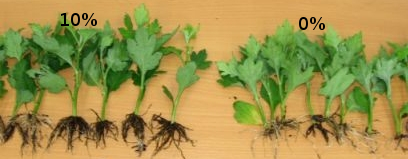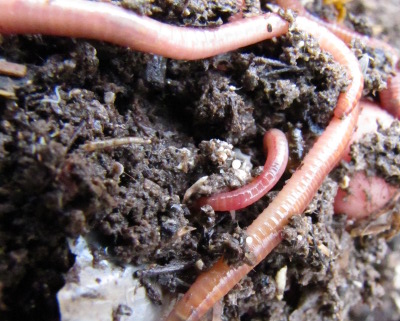
Worm castings vs. compost
 A
few months ago, one of our readers asked why
you would compost with
worms instead of just making a traditional compost pile, and I answered
"Um, well, errr, they're cute?" (Well, actually, I
made something up.)
Since then, I've been delving
into the literature to see whether vermicompost (aka worm castings) is
the same as traditional compost, and have discovered that there's
actually a big difference.
A
few months ago, one of our readers asked why
you would compost with
worms instead of just making a traditional compost pile, and I answered
"Um, well, errr, they're cute?" (Well, actually, I
made something up.)
Since then, I've been delving
into the literature to see whether vermicompost (aka worm castings) is
the same as traditional compost, and have discovered that there's
actually a big difference.
When you look at the
basic macronutrient levels found in compost and
worm castings, it actually looks like compost is the winner. NPK
values of compost will vary considerably depending on the raw materials
you use, but each macronutrient will range from 0.5 to 4% of the
compost's weight. On the other hand, NPK values of worm castings
can be as low as 0.1 or as high as 2, again depending on what you feed
the worms.
 Despite
the higher NPK values of compost, though, worm castings have a huge
positive effect on plant growth. When up to 20% of the soil
consists of worm castings, plants germinate better, grow faster, and
produce higher yields. Why?
Despite
the higher NPK values of compost, though, worm castings have a huge
positive effect on plant growth. When up to 20% of the soil
consists of worm castings, plants germinate better, grow faster, and
produce higher yields. Why?
The answer is that worm
castings are biologically and chemically
different from compost or soil. Worm castings have much
higher percentages of humus than either soil or compost, which helps
the castings hold more water and stay aerated, while also providing
binding sites for micronutrients
that would otherwise wash out of soil during heavy rains. The
castings are also chock full of plant growth promoters like cytokinins
and auxins, along with increased levels of micronutrients like calcium,
magnesium, and sulfur. Worm castings also host ten to twenty
times as much microorganism activity as plain soil. No wonder a
study showed that worm castings produced bigger blueberry plants and
higher fruit yields compared to blueberries treated with either cow
manure or chemical fertilizers.
| This post is part of our Hands-on Wormkeeping lunchtime series.
Read all of the entries: |
Want more in-depth information? Browse through our books.
Or explore more posts by date or by subject.
About us: Anna Hess and Mark Hamilton spent over a decade living self-sufficiently in the mountains of Virginia before moving north to start over from scratch in the foothills of Ohio. They've experimented with permaculture, no-till gardening, trailersteading, home-based microbusinesses and much more, writing about their adventures in both blogs and books.
Want to be notified when new comments are posted on this page? Click on the RSS button after you add a comment to subscribe to the comment feed, or simply check the box beside "email replies to me" while writing your comment.
- Remove comment

- Remove comment
- Remove comment
- Remove comment
- Remove comment
